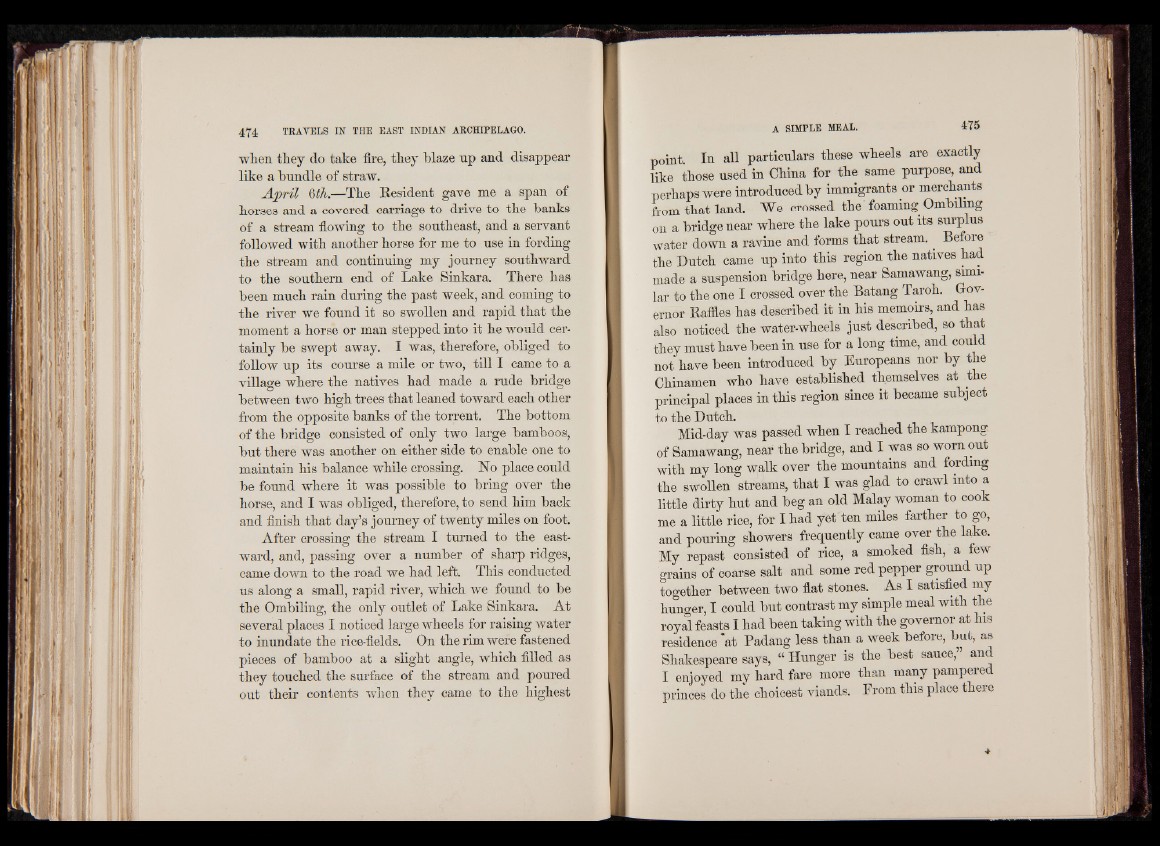
when they do take fire, they blaze up and disappear
like a bundle of straw.
A p ril 6th.—The Resident gave me a span of
horses and a covered carriage to drive to the banks
of a stream flowing to the southeast, and a servant
followed with another horse for me to use in fording
the stream and continuing my journey southward
to the southern end of Lake Sinkara. There has
been much rain during the past week, and coming to
the river we found it so swollen and rapid that the
moment a horse or man stepped into it he would certainly
be swept away. I was, therefore, obliged to
follow up its course a mile or two, till I came to a
v i l l a g e where the natives had made a rude bridge
between two high trees that leaned toward each other
from the opposite banks of the torrent. The bottom
of the bridge consisted of only two large bamboos,
but there was another on either side to enable one to
maintain his balance while crossing. No place could
be found where it was possible to bring over the
horse, and I was obliged, therefore, to send him back
and finish that day’s journey of twenty miles on foot.
After crossing the stream I turned to the eastward,
and, passing over a number of sharp ridges,
came down to the road we had left. This conducted
us along a small, rapid river, which we found to be
the Ombiling, the only outlet of Lake Sinkara. At
several places I noticed large wheels for raising water
to inundate the rice-fields. On the rim were fastened
pieces of bamboo at a slight angle, which filled as
they touched the surface of the stream and poured
out their contents when they came to the highest
point In all particulars these wheels are exactly
like those used in China for the same purpose, and
perhaps were introduced by immigrants or merchants
from that land. We crossed the' foaming Ombiling
on a bridge near where the lake pours out its surplus
water down a ravine and forms that stream. ^ Before
the Dutch came up into this region the natives had
made a suspension bridge here, near Samawang, similar
to the one I crossed over the Batang Taroh. Governor
Raffles has described it in his memoirs, and has
also noticed the water-wheels just described, so that
they must have been in use for a long time, and could
not have been introduced by Europeans nor by the
Chinamen who have established themselves at the
principal places in this region since it became subject
to the Dutch.
Mid-day was passed when I reached the kampong
of Samawang, near the bridge, and I was so worn out
with my long walk over the mountains and fording
the swollen streams, that I was glad to crawl into a
little dirty hut and beg an old Malay woman to cook
me a little rice, for I had yet ten miles farther to go,
and pouring showers frequently came over the lake.
My repast consisted of rice, a smoked fish, a few
grains of coarse salt and some red pepper ground up
together between two flat stones. As I satisfied my
hunger, I could but contrast my simple meal with the
royal feasts I had been taking with the governor at his
residence *at Padang less than a week before, but, as
Shakespeare says, “ Hunger is the best sauce,” and
I enjoyed my hard fare more than many pampered
princes do the choicest viands. From this place there